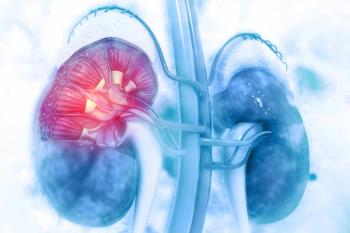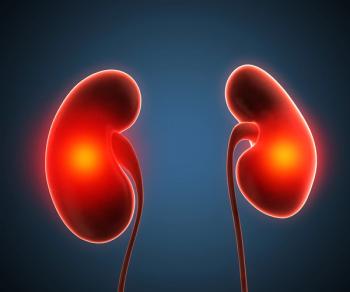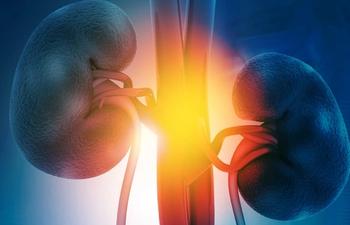
Treatment Options Expanding in Renal Carcinoma
First- and second-line treatment of clear cell RCC has changed dramatically, Dr. Eric Jonasch said during the NCCN Annual Conference in Orlando.
Clear cell renal cell carcinoma (RCC) is the most common type of kidney cancer, and for many years, the mainstay of treatment was cytokine therapy with interferon alpha (IFN-α) and interleukin-2 (IL-2). In fact, prior to the year 2000, high-dose IL-2 was the only approved treatment for patients with metastatic disease.
However, the situation has changed dramatically. “Things are very dynamic and exciting, and that’s especially good for patients,” said Eric Jonasch, MD, of the University of Texas MD Anderson Cancer Center, during the National Comprehensive Cancer Network (NCCN) Annual Conference, held March 22–24 in Orlando, Florida.
The armamentarium for RCC is rapidly increasing, for both the first- and second-line settings. In the first-line setting, Jonasch noted, “good risk” patients can benefit from treatment with sunitinib or pazopanib, while ipilimumab/nivolumab and cabozantinib are appropriate for intermediate and poorârisk patients.
“There is also a possible future role for combination [therapy with] atezolizumab/bevacizumab, although it is not currently FDA approved or on guidelines at this time,” he said.
For subsequent therapies, Jonasch explained that currently multiple agents have demonstrated an advantage in the second-line setting, including nivolumab, cabozantinib, and combination treatment with lenvatinib and everolimus.
“The selection of second-line agents will depend on patient disease status, comorbidities, and prior lines of treatment,” he said.
The adjuvant setting has been one of the recent areas of interest, but study results have been lackluster. Two of the three studies of adjuvant therapy that were completed have been completely negative, with only one showing an advantage. The positive study was the SâTRAC trial, in which sunitinib demonstrated improved disease-free survival (DFS) but not overall survival (OS) in patients at high risk of recurrence of RCC following nephrectomy.
The S-TRAC study compared adjuvant sunitinib to placebo in 615 patients with high-risk clear cell RCC post-nephrectomy. DFS was 6.8 years for patients who received active treatment, compared with 5.6 years for those in the placebo group (hazard ratio [HR] = 0.76; 95% CI, 0.59-0.98; P = .03).
“This was statistically significant,” said Jonasch. “There has been no overall survival advantage seen yet in this trial, and there was significant toxicity in the group that was treated.”
The NCCN guidelines were updated in accordance with these results. For patients with stage III disease or higher, adjuvant sunitinib has a category 2B recommendation. This was mainly due to the lack of an OS benefit, he pointed out, although that may change as more data from this trial become available.
The treatment for metastatic RCC has also changed significantly in the past few years, with several approved by the US Food and Drug Adminstration (FDA) and now available for different subsets of patients. One of the most recent agents to gain FDA approval is cabozantinib, an oral small-molecule inhibitor of vascular endothelial growth factor receptors, AXL, and MET. Approved in March 2016 for RCC that has progressed following tyrosine kinase inhibitor therapy, its indication was expanded in 2017 for patients with advanced disease.
Jonasch explained that in a phase II trial comprising 150 patients with intermediate- or poor-risk clear cell RCC who had not received any prior systemic therapy, cabozantinib proved superior to sunitinib. Progression-free survival (PFS) was 8.2 months with cabozantinib vs 5.6 months with sunitinib (P = .012). There was also a 34% reduction in the median rate of progression.
The number of approved therapies for metastatic clear cell RCC will probably also increase within the next few weeks, based on the results of two new large studies, he explained.
First to be reported, in the New England Journal of Medicine, are results from CheckMate 214, a large randomized phase III trial that compared combination ipilimumab and nivolumab to sunitinib in the first-line setting. The overall response rate was higher in patients in the combination therapy arm compared with the sunitinib arm (42% vs. 27%; P < .0001). Importantly, median PFS for intermediate- and high-risk patients favored combination therapy with ipilimumab plus nivolumab (11.6 months vs. 8.4 months; HR, 0.82; 95% CI, 0.64–1.05; P = .0331). OS was also superior in the combination therapy arm (NR [28.2–NE] vs. 26.0 months [22.1–NE]; HR, 0.63; 99.8% CI, 0.44–0.89; P < .0001).
Results from of a second phase III study, IMmotion151, were presented earlier this year at a meeting. This study compared the combination atezolizumab and bevacizumab to treatment with sunitinib, also in the front-line setting. The PFS outcomes in the intent-to-treat population also favored the combination regimen (median PFS, 11.2 months with the combination [95% CI, 9.6–13.3] vs 8.4 months with sunitinib [95% CI, 7.5–9.7]; HR = 0.83; 95% CI, 0.70–0.97). OS data are immature, and the median has not been reached in either study arm. A total of 29% of patients had an OS event at data cutoff.
“Atezolizumab plus bevacizumab shows superior progression-free survival as compared to sunitinb in all risk categories by prespecified investigator assessment, but there is no overall survival signal yet,” Jonasch said.
Jonasch also addressed the question of active surveillance in patients with metastatic disease. Based on the results of a small prospective, phase II study in 52 treatment-naive patients with asymptomatic metastatic RCC, active surveillance prior to systemic therapy appears to be an option for those with favorable-risk disease. The median surveillance time was 22.2 months in the “favorable” group vs 8.4 months in the “unfavorable” group (P = .0056).
“So the bottom line here is that it seems that active surveillance is an option for those with favorable risk,” Jonasch said. “This is reflected in the NCCN guidelines.”
Newsletter
Stay up to date on recent advances in the multidisciplinary approach to cancer.

















































































